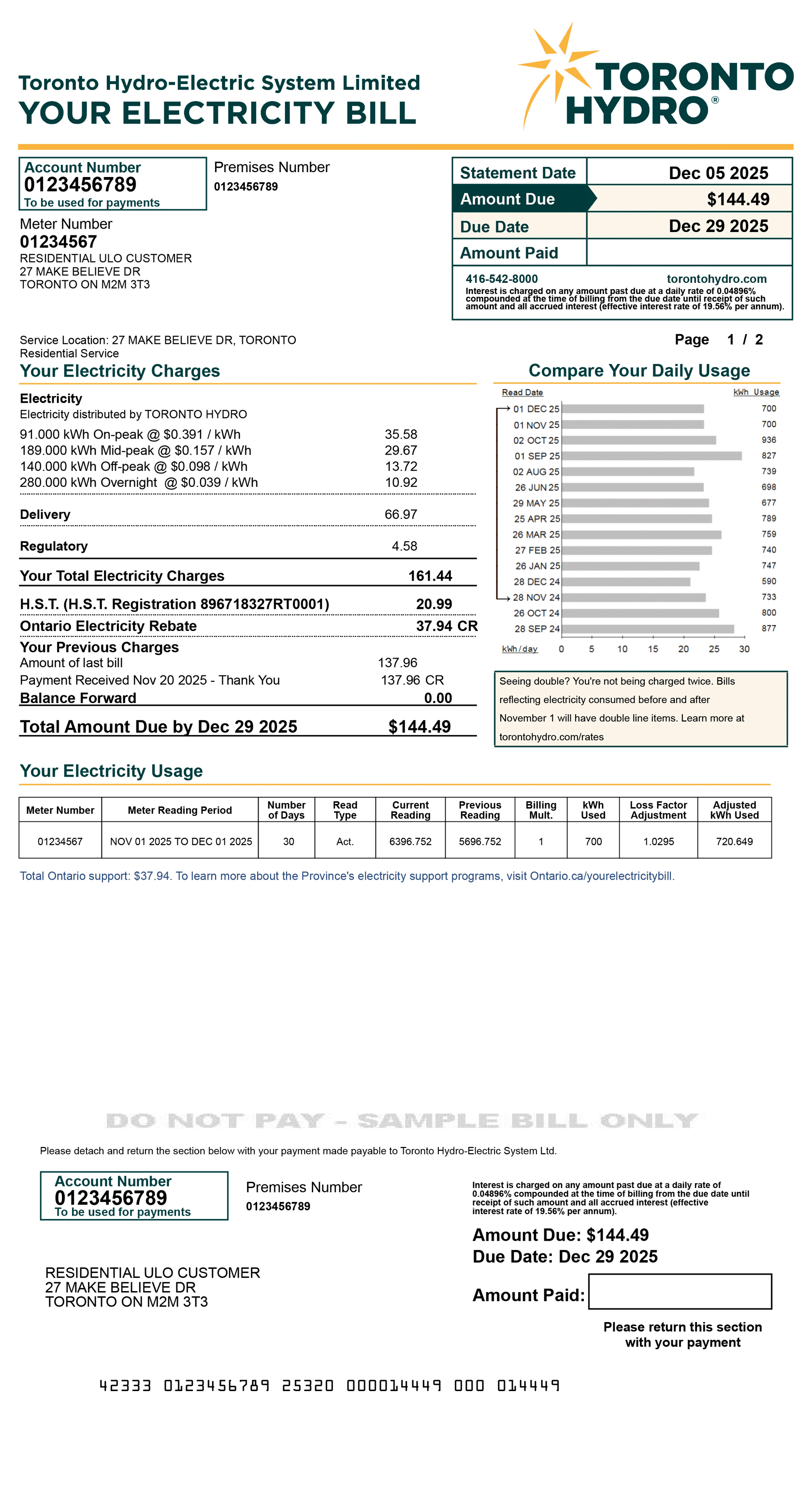Ultra-Low Overnight (ULO) sample bill
A detailed explanation of your monthly residential bill according to ULO pricing.
Download sample bill (PDF)

Residential ULO bill glossary
- 1: Premises Number
- Your Premises Number is a unique 10-digit number that identifies your property for billing and meter reading purposes.
- 2: Account Number
- Your Account Number is a 10-digit number that identifies your unique customer information profile with Toronto Hydro. This number is located in large bold numbers in the top left corner of your bill. You will need to reference this number when making payments, enrolling in conservation programs, signing up for online tools or contacting our Customer Care team.
- 3: Meter Number
- Your Meter Number is a unique number that identifies your meter with Toronto Hydro and allows us to collect accurate data for billing purposes.
- 4: Statement Date, Amount Due and Due Date
- The Statement Date identifies when the bill is prepared. Amount Due refers to the amount that you owe to Toronto Hydro. The Due Date indicates the last day that payment will be accepted before late fees are applied.
- 5: Page Count
- Your bill has more than one page. This includes the back of the bill, which has information on eBills, safety tips and more. You can access the back of the bill on the bills and payment history page in your self-serve portal.
- 6: Rate Class
- Residential customers are automatically assigned the “Residential Service” rate class. Your rate class defines your Delivery Charge rates as well as which rebate and electricity price plan options apply to you.
- 7: Compare Your Daily Usage
- This graph shows your electricity usage to help you track and manage seasonal trends. The 'Read Dates' along the left side of the graph indicates the dates when your meter reading was captured. Your consumption in kilowatt hours (kWh) is noted along the bottom of the graph. Each horizontal bar in the graph represents the average daily amount of electricity you consumed in kWhs for each billing period. The number indicated along the right side of the graph tells you the total amount of electricity consumption in kWhs you used in that billing period.
- 8: Electricity
- Electricity charges reflect the cost of the electricity that is purchased by Toronto Hydro on your behalf for usage in your home or business. Toronto Hydro does not charge a markup on this cost; it is paid directly to our suppliers. The pricing rates for electricity typically change in November each year. Your electricity consumption (kWh) is separated into four rates: on-peak (highest price), mid-peak (mid price), weekend off-peak and ultra-low overnight (lowest price). Note: If you've signed a contract with an electricity retailer, the company's name and phone number will also appear in this location.
- 9: Billing Period
- The billing period reflects electricity consumption, which is separated into into on-peak, mid-peak, weekend off-peak and ultra-low overnight. For more information, please visit our rates page.
- 10: Delivery
- The Delivery Charge covers the cost of delivering electricity from the generator to Toronto Hydro, and then to your home or business. This includes the costs to build and maintain the transmission and distribution lines, towers and poles and to operate provincial and local electricity systems.
- 11: Regulatory
- The Regulatory charge reflects the cost of administering the wholesale electricity system and maintaining the reliability of the provincial grid. Toronto Hydro does not charge a markup on this cost; it is paid directly to the Independent Electricity System Operator.
- 12: Ontario Electricity Rebate
- The Government of Ontario introduced the Ontario Electricity Rebate (OER) under the Ontario Rebate for Electricity Consumers Act, 2016. The OER provides eligible customers with a rebate on their electricity bill. For more information, please visit our website: torontohydro.com/oer
- 13: Important Message
- Remember to check this message box each month for important information that might affect your bill.
- 14: Meter Reading Period
- Your Meter Reading Period indicates the start and end date of when your electricity usage data (kWh) was captured for billing. A billing cycle ranges from approximately 27 to 33 calendar days. This means that your bill could reflect a period of electricity use that is longer than one month. You can tell the length of your billing cycle by reviewing the 'Number of Days' column on your past bill.
- 15: Read Type
- The Read Type indicates how your usage data (kWh) was gathered during your meter reading period. For the majority of customers, this will appear as "ACT," which indicates the reading is based on the actual kWh used. In some cases "EST" will appear, indicating the reading is based on the estimated number of kWh used.
- 16: kWh Used
- This value represents your total consumption (kWh) during your Meter Reading Period, and is used in calculating portions of the Delivery charges on your bill.
- 17: Loss Factor Adjustment
- The Loss Factor Adjustment represents Toronto Hydro's powerlines to your home for consumption. This factor is applied to your kWh Used to calculate the Adjusted kWh Used value on your bill.
- 18: Adjusted kWh Used
- The adjusted kWh Used value represents your total consumption (kWh) after the Loss Factor Adjustment is applied. This value is used to calculate portions of Delivery and Regulatory charges on your bill. This value is necessary in calculating these charges to recoup the costs associated with the generation and transmission of the electricity that is 'lost' as it travels along Toronto Hydro's powerlines to your home for consumption.